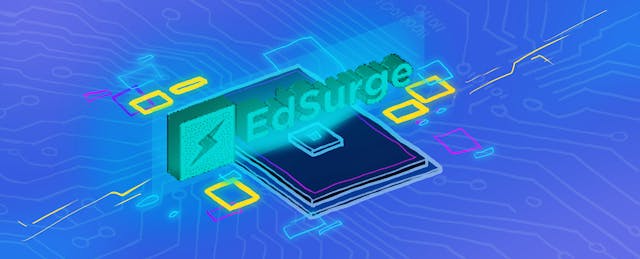Some of the loudest buzz in tech these days is about NFTs, a new high-tech way to format digital files that somehow led an artist named Beeple to sell a jpg for $69 million, a video clip of LeBron James dunking a basketball to go for more than $200 million at auction and a New York Times column about NFTs to score $560,000.
Since I write about education and tech, I wondered if there were applications in the world that EdSurge covers. And since so many people we talk to stress the value of experiential learning—and since this particular trend is so fast-moving and hard to illustrate—we decided to try minting and selling an NFT ourselves and document the process. Specifically, we are going to auction off an image of this article—the first NFT ever sold by EdSurge.
My first step, naturally, was to reach out to an educator who knows the NFT space. And I found Merav Ozair, an assistant professor of professional practice at Rutgers University’s business school. She’s a data scientist by training, and It turns out she has taught a few courses about blockchain, which is the technical framework that makes NFTs possible.

To explain what’s different about NFTs, she pointed to a recent example of a viral YouTube video that fetched a huge price. Specifically, the 2007 video known as Charlie Bit My Finger, which has been viewed more than 885 million times, sold as an NFT for more than $760,000.
“That’s not shabby for a video that most people have already seen,” notes Ozair. The value, she says, comes from the fact that blockchain allows a creator to essentially make an unchangeable watermark of authenticity that marks it as the original work. That’s pretty much the opposite of the way the internet and social media have traditionally treated information, which is to make it easy to make exact copies of something to spread to as many people as possible.
“If you see a painting in a museum you can take a picture of it, but it’s not the same—you don’t own it,” says Ozair. “But an NFT is like [an original] painting because it has an ownership in the code, and you can show it to everyone that you have it.”
That ability to make something that is one-of-a-kind is at the heart of the term NFT, which stands for non-fungible token. Monetary currencies are fungible, meaning that if I have, say, a quarter, it usually has the same cash value as all other quarters. But something non-fungible is a one-of-a-kind asset whose value can fluctuate.
But there’s another key feature of NFTs that I didn’t fully understand until I prepared to mint this article on the blockchain: These digital tokens can essentially contain digital contracts outlining the rights on how the buyer and creator can use the work in the future.
That idea was explained to me by a second-year medical student at the University of Minnesota, Carmen Aguirre. In her spare time (somehow) she’s a digital animator and graphic artist, who jet-sets around the world serving as a video jockey at concerts and music festivals (she goes by VJ Neurite). She says NFTs have given her a powerful new way to make income from her drawings and animation and reach audiences in new ways (and help pay for grad school).
Her latest series of artworks aims to break what she sees as a stigma around mental health. “I made 30 different monsters that are each a different emotion,” she explains. “And the entire goal of the project is really to raise awareness about communicating about our mental state and mental health. Specifically, the monsters are very cutesy and they are meant to be inviting and friendly.”
For her, the issue is personal, as she has wrestled with depression and anxiety. “There were points where I struggled to get out of bed or I struggled to get my homework done for school,” she says.
Here’s where the smart contract part of NFTs comes in: If the person who buys one of Aguirre’s NFTs decides to sell it in the future, Aguirre gets a cut of that secondary sale—a 10 percent royalty that’s automatically paid back to her virtual wallet. In fact, she will get a royalty every time one of her NFTs are resold, even if that happens years later.
And there are other terms that creators can set as well. In the case of Aguirre’s animated monsters, each buyer is also granted the rights to make a derivative version that they can distribute or sell. If EdSurge bought one of the monsters, which she priced at .08 ethereum (or about $300), that would give EdSurge the right to include it in this article, and even to include it in the NFT of this article we’re selling.
For an artist, that’s a revolutionary shift in how much control and compensation can be gained from a piece of creative work.
It’s this mix of creating one-of-a-kind digital works and embedded smart contracts that can set terms and the promise of ongoing royalties that has led folks in all kinds of industries to wonder if NFTs could shake things up. And that includes in education.
A New Kind of Diploma?
One idea is that NFTs could disrupt transcripts and resumes. An educator making that case is Beau Brannan, a visiting professor at Pepperdine University who also teaches a personal finance course at Oaks Christian School near Los Angeles.
He decided to experiment with awarding NFTs to students last semester in the high school finance course he teaches. These “academic tokens,” as he calls them, are not meant to have any direct monetary value. Instead each token proves the student passed the course and can contain unique details about how well the student did and information about the class, including the syllabus.
Brannan says that if educators or schools and colleges began issuing such tokens, students could then create online “trophy cases” of their NFTs to show prospective employers or others.
This teacher also asked his students to issue him an NFT, one that gave their reviews of how well he delivered the class material. One student was named a liaison and asked each classmate to give the teacher a number grade from .7 to 1.25, with 1 being adequate. The grades were averaged to give a final number included in the NFT. It’s a memento from the class for him to keep, and something he could show on his digital vita as well.
There are actually other experiments in redesigning the transcript to turn them into digital records—some of them use other kinds of blockchain approaches—and some observers argue that even simpler digital watermarking tech can do the trick. So it is possible that this tech is overkill for a use case like proof of academic achievement.
For Brannan though, NFTs tap into an emerging trend that many students are curious about, and so he argues they can help build community in a class even if this broader vision of rethinking transcripts never takes off. “It's just a little bit more student-friendly and kind of fun,” he says.
That fun factor has been embraced by other education groups as well. During the ISTE Live conference in June, for instance, the group made about 40 NFTs that it gave out as prizes in random drawings or as rewards for various forms of participation in sessions. “The goal was twofold,” said ISTE president Richard Culatta in an email interview: “1) to have a fun way to recognize amazing educators in a world where giving physical 'swag' wasn't possible and 2) to help educate more people about NFTs and how they work.” (ISTE is the parent organization of EdSurge.)
Textbooks and College Sports?
Some fans of NFTs see other potential uses in education down the road.
Some of them are explored on a new podcast series called The NFT PHD. The show is hosted by David Allan, a marketing professor at Saint Joseph’s University in Philadelphia who is also writing a textbook about NFTs.
I reached out to Mark Cuban—the billionaire owner of the Dallas Mavericks, a judge on the TV show Shark Tank, and an investor in NFT platforms—to ask what he sees on the horizon for classroom applications.
“The next best application is textbooks,” he responded to my email query. “They allow digital textbooks to be easily resold but more importantly they allow publishers and authors to collect royalties for every resale. Forever.”
Cuban has also been involved in a use of NFTs that’s already become a big business—sports collectables. There’s been added interest since the NCAA made its recent rule changes that allow colleges athletes some avenues to make money.
In fact, one of the best college basketball players of last season, Luka Garza, has spun up his own company to help college athletes sell NFT memorabilia (he’s past his NCAA eligibility). His first NFT trading card, which included highlights from his career playing for the University of Iowa, brought in more than $41,000 at auction.
In an interview with EdSurge, Luka’s father, Frank Garza, said hundreds of college athletes have contacted their company to find out more about it.
But What’s an EdSurge NFT Worth?
So here’s our experiment: We’re selling an image of this article as an NFT. There are several platforms that aim to make it easy to turn your digital file into an NFT and list it for auction, and we decided to use OpenSea.
Everyone we talked to stressed how easy it is to use these marketplaces, but there is a learning curve. And OpenSea requires buyers and sellers to make transactions in cryptocurrency, such as bitcoin or ethereum, instead of U.S. currency. And to transfer money into my OpenSea wallet from my personal bank account required a three-to-five- day wait (and by then, we were not able to buy one of Carmen Aguirre’s emotion monsters because they were already sold).
And there are often transaction fees, known as “gas fees,” for minting and selling NFTs.
There are a few legal points we need to be super clear about. One is that what we’re selling is a jpg of this article, not the version of the article you are reading right now. And the NFT does not include the intellectual property rights to our work.
All of the money from the sale will go to supporting the journalism we do here at EdSurge—we’re a nonprofit newsroom within ISTE. If we just get a few hundred bucks, that will pay for the custom illustration we commissioned for this article. If this gets big enough, we’d use it to support a series of articles on some topic we wouldn’t have been able to dive into without the extra funding. Unfortunately, though, the purchase of the NFT won’t be tax-deductible, because of some technicalities involving transferring the money from cryptocurrency to the ISTE bank account.
It’s a chance to own a small piece of journalism history and support EdSurge. You can check out the auction here.
We’ll do a follow-up story letting you know how we did—and what we learn.
Update: To find out what happened, read our follow-up story: Glitches, 'Gas Fees' and Lessons We Learned Selling an NFT.


